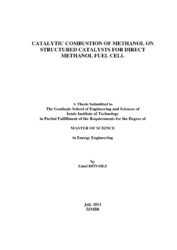Please use this identifier to cite or link to this item:
https://hdl.handle.net/11147/3100Full metadata record
| DC Field | Value | Language |
|---|---|---|
| dc.contributor.advisor | Şeker, Erol | - |
| dc.contributor.author | Dönmez, Emel | - |
| dc.date.accessioned | 2014-07-22T13:50:52Z | - |
| dc.date.available | 2014-07-22T13:50:52Z | - |
| dc.date.issued | 2011 | - |
| dc.identifier.uri | http://hdl.handle.net/11147/3100 | - |
| dc.description | Thesis (Master)--Izmir Institute of Technology, Energy Engineering, Izmir, 2011 | en_US |
| dc.description | Includes bibliographical references (leaves: 46-50) | en_US |
| dc.description | Text in English; Abstract: Turkish and English | en_US |
| dc.description | x, 59 leaves | en_US |
| dc.description.abstract | The major goal of this study is to investigate the effect of metal loading, space velocity and the outside temperature on both the steady state temperature of the alumina supported platinum catalysts and on time to reach at the temperature of 60 oC of a typical direct methanol fuel cell operating temperature in methanol combustion reaction. Alumina supported platinum catalysts were synthesized by using impregnation method and sol-gel made alumina. The methanol combustion reaction was performed in a tubular reactor.The characterization of the catalysts was performed by XRD and BET techniques. Particle size of Pt and surface area of the catalysts were compared before and after the reaction. In this study, it was found that the pure alumina was not active in methanol combustion whereas Pt/Al2O3 catalysts with varying loadings were active starting at room temperature. 2, 3 and 5% Pt loading catalysts showed the similar activity so it is possible that the average crystallite size and the crystallite size distribution of Pt on these catalysts would be similar. The space velocity tests indicated that low space velocity is required to quickly reach at 60 oC and also to achieve the highest steady state temperature for fresh catalyst whereas high space velocity is required to quickly reach at 60 oC and to achieve the highest steady state temperature for reused catalyst. The activity of the catalyst was also tested at sub-room temperatures. It was observed that the steady state temperature of the catalyst decreased and the time to reach at 60 oC increased when the outside temperature was below the room temperature. In addition to the tubular reactor, plate reactor was prepared for the methanol combustion. For this purpose, varying concentration alumina sols were coated on the stainless steel plates. However, optimum coating thickness could not be obtained because of the crack formation and peeling offs; thus, further detailed studies are necessary for obtaining stable coating suitable for the catalytic combustion. | en_US |
| dc.language.iso | en | en_US |
| dc.publisher | Izmir Institute of Technology | en_US |
| dc.rights | info:eu-repo/semantics/openAccess | en_US |
| dc.subject.lcsh | Fuel cells | en |
| dc.subject.lcsh | Methanol as fuel | en |
| dc.subject.lcsh | Platinum catalysts | en |
| dc.title | Catalytic Combustion of Methanol on Structured Catalysts for Direct Methanol Fuel Cell | en_US |
| dc.type | Master Thesis | en_US |
| dc.institutionauthor | Dönmez, Emel | - |
| dc.department | Thesis (Master)--İzmir Institute of Technology, Energy Systems Engineering | en_US |
| dc.relation.publicationcategory | Tez | en_US |
| dc.identifier.wosquality | N/A | - |
| dc.identifier.scopusquality | N/A | - |
| item.openairecristype | http://purl.org/coar/resource_type/c_18cf | - |
| item.cerifentitytype | Publications | - |
| item.languageiso639-1 | en | - |
| item.grantfulltext | open | - |
| item.fulltext | With Fulltext | - |
| item.openairetype | Master Thesis | - |
| Appears in Collections: | Master Degree / Yüksek Lisans Tezleri | |
Files in This Item:
| File | Description | Size | Format | |
|---|---|---|---|---|
| T000913.pdf | MasterThesis | 1.97 MB | Adobe PDF |  View/Open |
CORE Recommender
Page view(s)
226
checked on Apr 21, 2025
Download(s)
82
checked on Apr 21, 2025
Google ScholarTM
Check
Items in GCRIS Repository are protected by copyright, with all rights reserved, unless otherwise indicated.